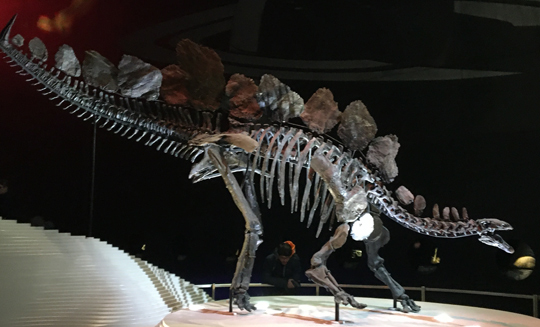Creating a New Stegosaurus Information Panel
Stegosaurus Information Panel
As part of our on-going work with an events management company Everything Dinosaur team members have been asked to prepare an information panel on Stegosaurus for an exhibition. Despite being one of the most popular of all the dinosaurs and a “terrible lizard” that the public find very easy to recognise, this genus has proved to be problematical for palaeontologists and ever since the first Stegosaurus was scientifically described back in 1877 by the American palaeontologist Othniel Charles Marsh, the stegosaur family have gone through several revisions.
The Bullyland Stegosaurus Dinosaur Model – Stegosaurus is One of the Most Famous of All the Dinosaurs

The image (above) shows the superb Bullyland Stegosaurus dinosaur model.
To view the range of Bullyland prehistoric animal figures: Bullyland Prehistoric Animal Figures.
In surveys conducted by Everything Dinosaur, to determine favourite prehistoric animals, Stegosaurus has been placed as high as three, with only Tyrannosaurus rex and Triceratops beating it in terms of popularity. Putting together a concise yet informative display panel for Stegosaurus represented quite a challenge.
The Stegosaurus Information Panel
Name: Stegosaurus
Means: Roof Lizard
Period: Late Jurassic, about 155-150 million years ago
Where have Stegosaurus Fossils been Found? Colorado, Utah and Wyoming in the USA and Portugal (Europe)
Stegosaurus was a slow-moving herbivorous quadruped and is perhaps one of the easiest dinosaurs to recognise thanks to its plates and tail spikes. However, ever since the first fossils of this iconic dinosaur were found in 1877 Stegosaurus has caused much controversy. For example, the famous American palaeontologist Othniel Charles Marsh, the first scientist to describe Stegosaurus, thought that the plates resembled the large flat bones that formed the shells of some types of prehistoric sea turtle.
Marsh suggested that Stegosaurus was an aquatic animal. It was not until 1891, after the discovery of several more specimens that the first skeletal reconstruction of Stegosaurus was completed. The hind limbs are much longer than the front limbs and it has been suggested that Stegosaurus could have reared up so it could feed on the branches of trees.
“Sophie” the Stegosaurus a Star Attraction at the London Natural History Museum

Picture credit: Everything Dinosaur
Bony Plate
Scientists are still debating what the bony plates were used for and how exactly they were arranged along the back. The plates are not attached to the spine but held in place with cartilage, tendons and muscles. It is thought that the plates were arranged in two alternating rows running down the back with the largest plates (up to 1 metre high), located over the hips. In this position the plates would have provided very little protection, it seems more likely that they played a role in species recognition or display behaviour. The bony plates may also have helped maintain body temperature by acting as heat regulators.
The largest species measured around 9 metres in length and weighed more than 3 tonnes. Stegosaurus also had two pairs of spikes on the end of its tail. These were probably defensive weapons.
To read an article about the research into the most complete Stegosaurus (S. stenops) specimen known to science: “Sophie” the Stegosaurus at 1.6 tonnes.
Visit the award-winning and user-friendly Everything Dinosaur website: Everything Dinosaur.

